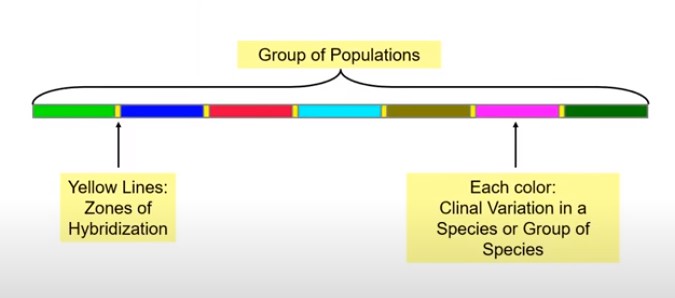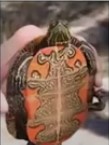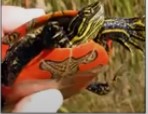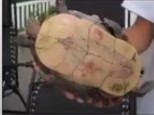
FNR24150 -- Week 12 Notes
Introduction
each population will adapt differently and will eventually diverge genetically (evolve) from other populations
if divergence continues, speciation would occur (rare outcome)
the rate of gene flow is a function of the closeness of the populations and the dispersal tendency of the species
Classification
Species
Today distinguishes by differences in:
body function
biochemistry
behaviour
genetic makeup
Classical Biological Concept Definition:
genetically distinctive populations of individuals isolated reproductively from all other populations
Alternative species concepts
27-30 concepts
Ecological species
defined in terms of its ecological niche
Morphological species
defined by morphology (structure)
Genealogical species
defined as a set of organisms with a common and unique genetic history as shown by molecular patterns
Subspecies
Def 1:
Taxonomic subdivision of a species
Def 2:
A population of a particular region genetically distinguishable from other populations and capable of interbreeding with them
Def 3:
A grouping of organisms that differ from other members of their species by color, size, or various morphological features
Cline
A gradual and continual change in a character by a series of populations or throughout the range of a species
Usually along a geographic or environmental gradient
Individuals at the two extremes differ
Clinal Variation
Clinal Variation in plastral markings of painted turtles
Western forms -- intricate
Hybrid -- intermediate
Midwestern/Midland -- single
“Ring species”
Individuals that don’t interbreed but all stem from one population

Lungless salamander (Ensatina eschscholtzi)
Morphological Variation
Latitudinal changes within a species
Changes in body weight; Bergman’s rule
Animals have a tendency to be larger in polar regions, medium in temperate climates, and smallest in tropical ones
DOES NOT ALWAYS APPLY TO REPTILES & AMPHIBIANS
Changes in body color
Biogeography
3 major factors influence geographic distributions of amphibians & reptiles
Climate
Amphibians have 3 factors in regards to climate
Temperature
Rainfall
Periodicity
Availability & access to resources
Dispersal abilities
Small fossorial amphibians & reptiles have poorer dispersal abilities
Large aquatic animals tend to be better dispersers
Movements
Daily Movements
Feeding
Thermoregulation
Predator avoidance
Seasonal Movements
Generally more extensive but still generally considered to be <0.5 km
Breeding
Amphibians generally go towards water
Reptiles generally go towards land
Hibernation
Snakes searching for hibernacula to escape the cold
Habitat Utilization
Largely associated with change in food availability or habitat quality
Dispersal
Movement outward from home area; often implies colonization
Important for maintaining gene flow in a population
Infers some genetic exchange (if those dispersing individuals successfully reproduce)
Undirected movement to locations unknown by the dispersing animals
Costs & benefits
Benefits
May reduce intra-specific competition
Likely to come into contact with different individuals unrelated to you (minimizes inbreeding)
Costs
Resources could be lacking
Increased predation risk
Orientation & Navigation
Piloting
Simplest form; ability to recognize landmarks
Possessed by all reptiles & amphibians
Compass orientation
Sense of direction
Independent of local cues (i.e. basking/perching sites)
True navigation
Ability to orient & move toward a location; an internal map
Others
Visual orientation (polarized light)
Pineal organ (salamanders)
Parietal eye (dictates photoperiod)
Olfaction
Celestial (stars & celestial bodies)
Orientation in baby Loggerhead Turtles (Chelonia mydas)
Visual cues
Uses stars & moon to help hatchlings find ocean
Wave Orientation
Takes them out into the ocean
Magnetic Orientation
Home Range
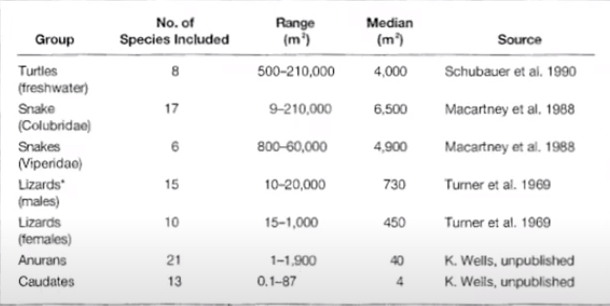
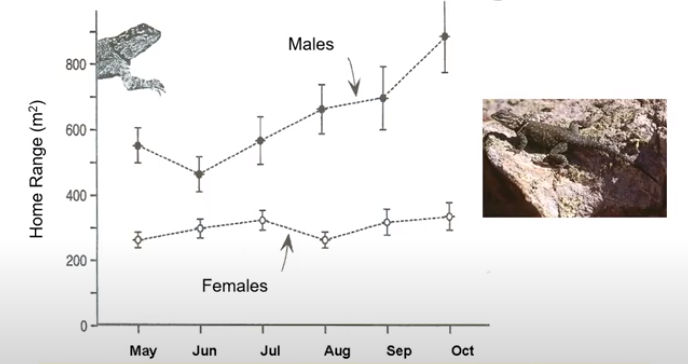
Home range varies between the sexes
larger in males, smaller in females
male home range size 2x amount of female and is increasing
Defense (Territoriality)
Usually very expensive, but where a required resource is insufficient for all individuals, defense may have evolutionary advantage
Types
Territorial defense
Relatively rare
Mark territory with pheromones
Accomplished through direct combat
Site defense
More common
Defense of point resource
Basking sites, food, nesting
FNR24150 -- Week 12 Notes
Introduction
each population will adapt differently and will eventually diverge genetically (evolve) from other populations
if divergence continues, speciation would occur (rare outcome)
the rate of gene flow is a function of the closeness of the populations and the dispersal tendency of the species
Classification
Species
Today distinguishes by differences in:
body function
biochemistry
behaviour
genetic makeup
Classical Biological Concept Definition:
genetically distinctive populations of individuals isolated reproductively from all other populations
Alternative species concepts
27-30 concepts
Ecological species
defined in terms of its ecological niche
Morphological species
defined by morphology (structure)
Genealogical species
defined as a set of organisms with a common and unique genetic history as shown by molecular patterns
Subspecies
Def 1:
Taxonomic subdivision of a species
Def 2:
A population of a particular region genetically distinguishable from other populations and capable of interbreeding with them
Def 3:
A grouping of organisms that differ from other members of their species by color, size, or various morphological features
Cline
A gradual and continual change in a character by a series of populations or throughout the range of a species
Usually along a geographic or environmental gradient
Individuals at the two extremes differ
Clinal Variation
Clinal Variation in plastral markings of painted turtles
Western forms -- intricate
Hybrid -- intermediate
Midwestern/Midland -- single
“Ring species”
Individuals that don’t interbreed but all stem from one population

Lungless salamander (Ensatina eschscholtzi)
Morphological Variation
Latitudinal changes within a species
Changes in body weight; Bergman’s rule
Animals have a tendency to be larger in polar regions, medium in temperate climates, and smallest in tropical ones
DOES NOT ALWAYS APPLY TO REPTILES & AMPHIBIANS
Changes in body color
Biogeography
3 major factors influence geographic distributions of amphibians & reptiles
Climate
Amphibians have 3 factors in regards to climate
Temperature
Rainfall
Periodicity
Availability & access to resources
Dispersal abilities
Small fossorial amphibians & reptiles have poorer dispersal abilities
Large aquatic animals tend to be better dispersers
Movements
Daily Movements
Feeding
Thermoregulation
Predator avoidance
Seasonal Movements
Generally more extensive but still generally considered to be <0.5 km
Breeding
Amphibians generally go towards water
Reptiles generally go towards land
Hibernation
Snakes searching for hibernacula to escape the cold
Habitat Utilization
Largely associated with change in food availability or habitat quality
Dispersal
Movement outward from home area; often implies colonization
Important for maintaining gene flow in a population
Infers some genetic exchange (if those dispersing individuals successfully reproduce)
Undirected movement to locations unknown by the dispersing animals
Costs & benefits
Benefits
May reduce intra-specific competition
Likely to come into contact with different individuals unrelated to you (minimizes inbreeding)
Costs
Resources could be lacking
Increased predation risk
Orientation & Navigation
Piloting
Simplest form; ability to recognize landmarks
Possessed by all reptiles & amphibians
Compass orientation
Sense of direction
Independent of local cues (i.e. basking/perching sites)
True navigation
Ability to orient & move toward a location; an internal map
Others
Visual orientation (polarized light)
Pineal organ (salamanders)
Parietal eye (dictates photoperiod)
Olfaction
Celestial (stars & celestial bodies)
Orientation in baby Loggerhead Turtles (Chelonia mydas)
Visual cues
Uses stars & moon to help hatchlings find ocean
Wave Orientation
Takes them out into the ocean
Magnetic Orientation
Home Range


Home range varies between the sexes
larger in males, smaller in females
male home range size 2x amount of female and is increasing
Defense (Territoriality)
Usually very expensive, but where a required resource is insufficient for all individuals, defense may have evolutionary advantage
Types
Territorial defense
Relatively rare
Mark territory with pheromones
Accomplished through direct combat
Site defense
More common
Defense of point resource
Basking sites, food, nesting
 Knowt
Knowt